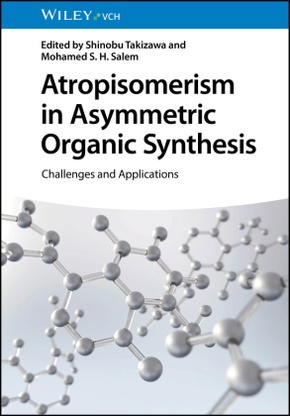Atropisomerism in Asymmetric Organic Synthesis - Challenges and Applications
| Verlag | Wiley-VCH |
| Auflage | 2024 |
| Seiten | 352 |
| Format | 17,5 x 2,3 x 1,5 cm |
| Gewicht | 666 g |
| Artikeltyp | Englisches Buch |
| ISBN-10 | 352735283X |
| EAN | 9783527352838 |
| Bestell-Nr | 52735283A |
Presents new methodologies, strategies, and unique catalysts emerged in the oxidative heterocoupling area and tackles some everlasting challenges.
Inhaltsverzeichnis:
Preface
PART I ATROPOSELECTIVE SYNTHESIS
1 Introduction
1.1. Molecular chirality and atropisomerism
1.2. Atropisomerism in asymmetric organic synthesis
1.3. Atropisomerism: Challenges and applications
2 Iron- and Ruthenium-catalyzed Atroposelective Synthesis of Axially Chiral Compounds
2.1. Introduction
2.2. Oxidative homocoupling of 2-naphthols to BINOL and its derivatives
2.3. Oxidative cross-coupling of 2-naphthols to asymmetric BINOLs
2.4. Oxidative spirocyclization of 2-naphthols
2.5. Conclusion
3 Vanadium-catalyzed Atroposelective Coupling of Arenols and Application in the Synthesis of Polycyclic Heteroaromatics PHAs
3.1. Introduction
3.2. Chiral vanadium catalysis in homo-coupling of hydroxycarbazoles
3.3. Chiral vanadium catalysis in hetero-coupling of hydroxycarbazole with 2-naphthols
3.4. Enantioselective synthesis of oxa[9]helicenes via chiral vanadium complex-catalyzed homo-couplings of polycycl ic phenols
3.5. Enantioselective synthesis of oxaza[7]dehydrohelicenes via chiral vanadium complex-catalyzed hetero-couplings of 3-hydroxycarbazoles and 2-naphthols
3.6. Summary and Conclusion
4 Atroposelective Suzuki?Miyaura coupling towards Axially Chiral Biaryls: Mechanistic Insight
4.1. Introduction
4.2. Mechanism insight of SMC reaction and enantiodetermining step
4.3. Asymmetric SMC reaction
4.4. Conclusion
5 Organocatalytic Enantioselective Formation of Atropisomers
5.1. Introduction
5.2. Aminocatalysis
5.3. Brønsted base catalysis
5.4. Phase Transfer Catalysis
5.5. Chiral Phosphoric Acids
5.6. Conclusions
6 Synthesis of Atropisomers via Enantioselective Ring-Opening Reactions
6.1. Introduction
6.2. Asymmetric ring-opening of biaryl lactones and its derivatives
6.3. Asymmetric ring-opening reactions via C-I bond cleavage
6.4. Asymmetric ring-opening reactions via C-N and C-P bonds cleavage
6.5. Asym metric ring-opening reactions via C-C and C-Si bonds cleavage
6.6. Asymmetric ring-opening reactions via C-O and C-S bonds cleavage
6.7. Oriented asymmetric ring-opening via transient pentacyclic metal species
6.8. Summary and Conclusions
PART II CHALLENGES AND APPLICATIONS
7 Axially Chiral Ligands and Catalysts Derived from Atropisomeric Binaphthyl Structures
7.1. Introduction
7.2. Chiral ligands derived from BINOLs
7.3. Chiral ligands derived from BINAMs
7.4. Chiral ligands derived from NOBINs
7.5. Chiral organocatalysts derived from BINOLs
7.6. Chiral organocatalysts derived from BINAMs
7.7. Chiral organocatalysts derived from NOBINs
7.8. Chiral ligands and catalysts derived from other Binaphthyl motifs
7.9. Summary and Outlook
8 Multinuclear Zinc Catalysts with Axially Chirality
8.1. Pioneering works on BINOL-Zn System
8.2. Enantioselective addition reaction of dialkylzinc to aldehydes using BINOL additive
8.3. Catalytic asymmetric alkynylation of aldehydes
8.4. Catalytic asymmetric Diels-Alder reaction
8.5. Catalytic asymmetric epoxidation of enones
8.6. Catalytic asymmetric direct Aldol reaction
8.7. Catalytic asymmetric iodofunctionalization of alkenes
8.8. Conclusions
9 Binaphthyl-based Chiral DMAP Derivatives in Enantioselective Transformations
9.1. Introduction
9.2. Binaphthyl-based chiral DMAP derivatives
9.3. Intramolecular acyl transfer reactions
9.4. Intermolecular acyl transfer reactions
9.5. Summary and Conclusions
10 Catalytic Atroposelective Oxidative Coupling in Natural Product Synthesis
10.1. Introduction
10.2. Copper-catalyzed asymmetric oxidative coupling to construct a chiral axis
10.3. Vanadium-catalyzed asymmetric oxidative coupling to construct a chiral axis
10.4. Enzymatic strategies to synthesize natural products via atroposelective coupling
10.5. Conclu

